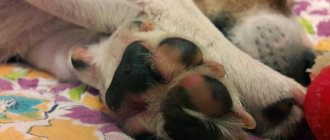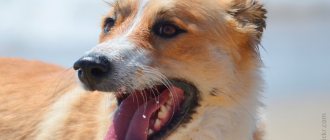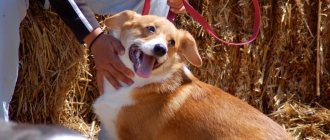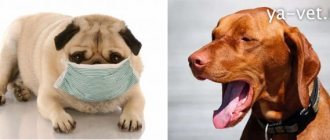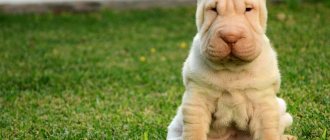Any responsible owner will suspect something is wrong if he discovers that his dog is shedding in winter. A small and short-term loss of hair can be attributed to stress, but what to do if your pet’s fur coat is literally crawling. Should winter molting be considered a symptom of an illness? Let's figure out what could be the reasons for unexpected hair loss and what to do next.
Almost all dog breeds shed their fur and undercoat twice a year – in autumn and spring. This is a necessary and natural process of renewing the fur coat and skin. If the owner brushes the dog daily, the process lasts 1–2 weeks. In long-haired breeds and dogs with a solid undercoat, shedding can last for three weeks and there is nothing suspicious here.
Untimely shedding as a symptom
In most cases, the owner does not notice a number of warning symptoms, after which hair loss occurs. If your dog has started shedding in the winter, look back over the previous 2-3 weeks to see if you may have noticed your dog itching or being overly fussy.
Examine your pet's skin; if there are red areas and scratches, you are most likely dealing with dermatitis. It’s too early to rejoice; dermatitis is a very vague diagnosis and cannot be treated arbitrarily.
A strange, sharp, unusual smell for a dog is also a symptom. A change in odor indicates abnormal functioning of the skin glands. This phenomenon can have a dozen reasons, from low-quality shampoo to a piece of “goodies” picked up in the trash. Even if there was no smell before the molting began, you should not forget about this symptom. By the way, the first source of “incense” is the dog’s ears and paws. In the second case, the smell is a variant of the norm, in the first, it indicates otitis media or a milder inflammatory process.
Has your dog been nervous in the last few weeks? Maybe you scolded your pet (even for good reason)? Fights, injuries, visits to the vet, or any other stress can trigger shedding. However, with this development of events, hair loss should not be intense and should stop within 2-3 days. On the other hand, stress can trigger any “dormant” sore, so strictly monitor the condition of your pet as a whole, and not just its fur coat.
Causes not related to diseases
Often it is the owner who is the culprit for the sudden molting of the pet, as he does not properly care for him. Most breeds do not require frequent washing, since such procedures can damage the protective layer of the skin and coat, especially if you bathe the dog with shampoos. But often owners try to overprotect their pet, trying to rid it of the characteristic dog smell or thinking that an unwashed dog is not feeling well.
When, after frequent bathing procedures, the natural lubricant disappears and does not have time to be restored, the dog’s skin becomes dry, dandruff may appear, the hair loses its natural shine and elasticity, breaks and falls out.
First of all, it is worth considering what breed your four-legged friend is, and in order not to harm him, it is advisable to consult with a breeder or veterinarian about proper care.
Sometimes it is enough for a dog to lie in the snow in winter to clean his coat, and in summer - to swim in the nearest body of water. Pets with short fur can be treated with dry shampoo or wipe the contaminated areas with a velvet napkin.
Another reason is a change in climate or living conditions for the pet. If a family moves from a cold climate to a warm one, the dog’s body reacts immediately, without waiting for the right season, by getting rid of the excessively abundant undercoat.
The same thing happens when a street dog is taken to live in a house or apartment. In such a situation, the need for a thick, warm fur coat disappears, and it begins to slowly shed. Over time, it becomes sparser, less thick and voluminous.
Owners who plan to change the dog’s place of residence more than once should pay attention to this nuance. It will take time for him to get used to the street again. Usually, the dog is gradually released outside when the weather is cool, but not frosty, increasing the time he spends in such conditions. And a little later they leave it overnight. But this should be done before frosts begin, so that the undercoat develops again.
Parasites and fungal infections
Fleas and ticks can “attach” even to a pet that has been treated for parasites. Carefully examine your dog, especially the areas behind the ears, chin, belly area, and inner thighs. Look not only for parasites, but also for traces of their presence - black specks, red dots (bites), scratches. Carefully inspect the litter, and at the slightest suspicion, change it to fresh one. If there is dark plaque in your pet's ears, clean it and observe whether your pet may have ear mites.
Lice eaters are a separate epic, before which even experienced dog breeders tremble. An infected dog sheds heavily in winter and all year round until it becomes critically bald. The problem is the difficulty of diagnosis. Let's just say they will find the parasite if they're lucky. The mite does not eat the hair itself (as you might think from the name), it climbs into the hair follicle and parasitizes there.
By the way, the lice eater, unlike its tick brothers, does not suck blood, but gnaws skin and tissue. At advanced stages of the disease, the “neighbors” move into the deeper layers of the skin. In addition to all the delights, the lice eater can infect the dog with worms, since it is their intermediate host.
Worms live in the dog's body, but have a detrimental effect on the entire body. Do not forget that parasites can live not only in the intestines; some species can travel throughout the body, affecting the heart, liver, lungs and even the brain.
The dog sheds constantly, all year round: reasons
Causes of shedding:
- Hormonal disbalance
- Disturbances in the gastrointestinal tract
- Worms
- Dermatitis
- Other parasites
- Stress
- Low indoor humidity
- Heat
The dog sheds constantly, all year round: reasons
How to stop winter shedding in a dog
Self-treatment is a big responsibility, since a mistake can lead to tragedy or complications. So, attempts at self-medication can be made if the dog eats well, behaves normally, does not have an elevated (low) temperature and does not experience any symptoms other than hair loss. You should not experiment for more than a week, if the methods below do not help, go to the veterinarian!
- Treat your dog for parasites! Even if you recently carried out preventive measures, repeat, perhaps you came across low-quality drugs or your pet “picked up the neighbors” from four-legged walking buddies.
- Diet and vitamin course - neutral diet or switch to higher quality food. Nutritional supplements should contain vitamins A, E, D, Omega 3 and 6, calcium, magnesium and phosphorus.
- Check the air temperature and humidity in your home. At temperatures above 25°, shedding is normal. Too dry air (below 40%) can also lead to damage and loss of hair. We eliminate the factors by ventilation, lowering the temperature level on thermostats (if they have them), and purchasing an air humidifier.
- Rest is stress, the cause of all diseases, this law is also true for dogs. Protect your pet from group walks, guests and “babysitting” for at least a week. Perhaps the tailed one was mentally tired, and his body began to “give up” physically.
- Walk your dog 2-3 times a day , even in bad weather. Moderate cooling will stop molting. However, do not go too far, the dog may become hypothermic, which will lead to a cold at best, bronchitis and pneumonia at worst.
Advice: when contacting the clinic, insist on general and biochemical blood tests, “spot” (one indicator) tests of the condition of the liver, kidneys, thyroid and pancreas, taking a deep skin scraping with subsequent examination for fungi and parasites.
Answer
Hair loss in a German Shepherd is a direct indication that the animal has health problems. It is not possible to definitively determine a pet’s disease without examining a veterinarian. Let's consider possible options for pet skin diseases and how to help your dog at home.
A dog's fur may fall out due to the presence of parasites, skin diseases, allergies and hormonal imbalances. In addition to external or internal pathological reasons, dog hair loss is caused by age.
What to scratch with?
- To remove tangles from the undercoat, you will need a comb made of hardened steel; it would be nice if it was coated with nickel.
- Where a metal tool is not suitable, a more delicate slicker brush will come in handy. Suitable for use in delicate areas.
- A glove-shaped brush is good at removing dead hair from a dog’s body.
- You can quickly rid your beloved pet of dead hair by using a furminator after bathing. The tool should be moved along the growth of the fur, carefully and without pressure.
Important!
The dog should not have tangles, which means that before the procedure it is necessary to comb out the hair with a comb or metal comb. If this is not done, the pet will be in too much pain.
Treatment
Shedding cannot be stopped overnight. The owner of the animal must take a whole range of measures in order to alleviate the condition of his pet. Based on the diagnosis, the veterinarian will prescribe treatment that must be followed. Treatment directly depends on the cause that caused such processes in the body.
Hormonal disorders
Hormonal problems are treated by taking estrogens and androgens in minimal proportions. The doctor independently sets the dosage and duration of administration. Every 90 days, the doctor will monitor the health status of his patient. Chloditan is also prescribed 50 ml daily for 2 weeks. Later, the doctor decides to reduce the dose. In some situations, the patient may be prescribed Lugol's solution from 5 to 10 drops.
Decreased immunity
Drugs that have a detoxifying effect help to effectively cope with this problem. They increase the body's resistance to stress and stress. The following immunostimulants are offered for dogs:
- Maxidin;
- Glycopene;
- Immunofan;
The duration of the course and dosage are prescribed only by the attending veterinarian. Dogs can also be prescribed vitamins in tablet form. Vitamins are given to dogs crushed or dissolved in food. Vitamins should contain the following substances:
- vitamins A, B;
- a nicotinic acid;
- ascorbic acid;
- zinc;
- selenium;
- iron.
Kidney failure
Kidney failure, depending on the stage of development of the disease, is treated in several ways:
- antibiotics (Amoxicillin and Biseptol);
- diuretics such as Furosemide;
- drugs containing potassium (Asparkam);
- drugs that eliminate putrefactive processes (Vitom and Lactusan);
- antispasmodics (No-shpa and Papaverine).
- Azinox;
- Azinox plus;
- Dirofen;
- Transit;
- Holiday plus.
Video - How to deal with shedding
Tools for combing wool
To carefully comb out loose hair and painlessly remove formed tangles, there are various devices:
- comb made of hardened steel, the best option is nickel plated. This tool is most often used for grooming the undercoat;
- slicker This brush is suitable for sensitive dogs who cannot tolerate a metal comb. She carefully and delicately combs out the accumulated hair;
- A glove brush is used to comb out and collect dead hairs. It fits comfortably on your hand and effectively removes hair;
- The furminator is a modern tool that can replace all of the above devices. The Furminator is similar to a comb, but has a steel blade with teeth and a comfortable rubber handle. Thanks to the slotted blade, the undercoat is easily removed from the coat without damaging living hairs.
Important: you cannot use the furminator if there are irritations, sores, wounds or similar damage on the animal’s skin. Also, the use of the device is not allowed if the dog has mats. In this case, they must be carefully removed in advance so that the furminator does not cause pain to the animal.
Regular brushing of your dog will prevent hair from settling on the furniture and floor. The most convenient way to deal with hair is to place your pet on newspaper or cellophane. This will help you remove lost hair very quickly.
